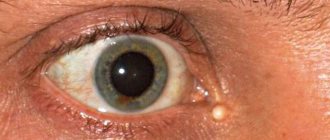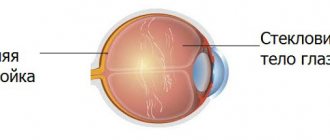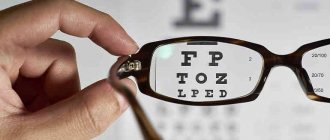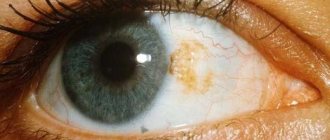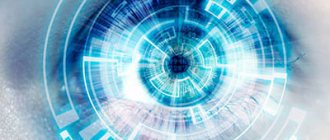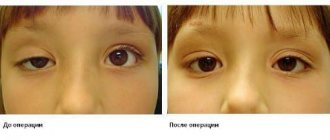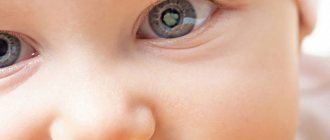Pleoptics is a system of medical methods for treating amblyopia. These include: occlusion; penalization; limited exposure of the macula according to Avetisov; Küppers method - sequential presentation of negative images on a monobinoscope or a large non-reflex ophthalmoscope; Campbell's method, implemented in the Illusion device (modified by V.M. Cherednichenko et al.) - contrast sensitivity training; reflexology; training on a localizer corrector, as well as other devices of a similar type.
Occlusion method
Direct occlusion is considered the main, traditional option for pleoptic treatment of amblyopia with exclusion of the healthy eye from the visual act. It creates fixation for the squinting eye, which helps to connect it to active work. To implement the method, you need certain plastic occluders that are attached to the frame of glasses, or homemade soft curtains. The occlusion wearing regimen is recommended by the doctor. Typically, full or translucent occlusion is carried out all day; several hours daily or every other day, depending on the degree of vision impairment.
In some cases, prolonged restriction of vision in the squinting eye provokes deterioration of vision in the dominant eye. This becomes the reason for the transition to the method of alternating occlusion. For example, the dominant eye is turned off for 6 days, then the amblyopic eye is turned off for 1 day, or, respectively: 5 days and 2 days, etc. Despite a significant increase in visual acuity in the amblyopic eye or even achieving the same visual acuity in both eyes, it is not uncommon for patients, strabismus remains monolateral, i.e. The vision of an amblyopic eye begins to gradually deteriorate after the occlusion ceases. In this case, they need to repeat the occlusal treatment regularly. This will help maintain high visual acuity until the age of 4-6 years, when treatment can be supplemented with a set of additional techniques (orthoptic exercises) or surgery.
The main goal of direct occlusion is to temporarily deteriorate the vision of the healthy eye in order to enable the eye with amblyopia to become the “leading” eye. That is, there is no need to completely eliminate the eye that sees better from the vision process when performing direct occlusion. When performing direct occlusion, it is worth using screens of different densities of neutral light filters, which will reduce the vision of the better seeing eye to the required extent.
If the vision of an amblyopic eye is very low (0.1 or less), very often the child does not allow direct occlusion and its implementation is seriously difficult. In such cases, you can turn off your dominant eye. First, for 1-2 hours daily, then the time must be increased or a translucent occluder must be used, moving from transparent films to less translucent or opaque ones. To make the use of the dominant eye absolutely impossible, it should also be covered from the sides.
It must be remembered that with prolonged occlusion, binocular relationships may be disrupted, so it is worth using tactics of a gradual transition to other treatment methods or using penalization.
Ortho- and diploptics
These techniques are aimed at restoring binocular vision through the development of its individual functions. Orthoptics uses installations with forced separation of visual fields, while diploptics provides the possibility of treatment in natural visual perception.
Orthoptic exercises are performed on the synoptophore with the aim of developing bifosal fusion. Each eye sees an individual test object set at a deviation angle and is subjected to alternating or simultaneous light stimulation (blinking). During the procedure, the blinking frequency increases. The exercises are carried out in a course of 20 procedures at intervals of several months.
Orthoptic methods are good at the initial stage of the onset of pathology, but over time at later stages of diagnosis they become ineffective. In addition, there are difficulties in adapting visual perception after a treatment course, since the conditions of artificial separation of visual fields differ significantly from natural vision.
Diploptics is aimed at eliminating the suppression of visual stimuli from the diseased eye due to the state of diplopia (double perception). This is achieved using a prism system. In ophthalmology, various diploptic devices are used, designed for the development of fusion, bifixadia, as well as binocular accommodation (“Diploptik-P”, “Diploptik-SF”, “Fotbis”, etc.).
The systems of color separation of visual fields used in the “EYE” programs, “Contour” are an example of chromatic diploptics and are actively used for binocular training.
The phase haploscopy method is based on the theory of alternate supply of information from each eye and disturbances that change this queue. With the help of liquid crystal glasses that change their transparency with a certain frequency, the patient's depth vision is corrected. A similar effect is achieved using stereoscopes, the Howard-Dolman device, etc.
Penalization method
The principle of the penalization method is to cause temporary anisometropia in the patient, with deterioration of vision in the dominant eye, so that the amblyopic eye becomes fixative. A similar situation can be easily achieved by assigning glasses to the dominant eye, which will significantly worsen its vision, which will create the necessary working conditions for the amblyopic eye. This method makes it possible to involve the amblyopic eye in active work without excluding the better-seeing eye from the act of vision (as in the case of occlusion).
If visual acuity is low and the child does not allow either occlusion or spectacle penalization, it is advisable to use penalization using medicinal methods, i.e. instill mydriatics into a healthy eye. This method has significant advantages, especially in the case of convergent strabismus, because under the influence of mydriatics, accommodation stops working and, accordingly, convergence decreases.
Electrical stimulation
Electrical stimulation in pleoptics is the activation of visual processes through the influence of weak electrical impulses on the neuromuscular tissue of the eye. For electrical stimulation in pleoptics, pulsed current of various forms is used:
- pointed,
- rectangular,
- exponential.
Electrical stimulation improves metabolic processes, blood circulation, enhances the reflex interaction of the central nervous system with the visual analyzer, while restoring all functions.
Modern ophthalmologists note the effectiveness of electrical stimulation. Visual acuity increases, light and color perception increases, and the accommodation reserve increases.
Blinding method
Performing local “blinding” illumination of the central fovea of the retina is possible on certain ophthalmological devices - a large non-reflex ophthalmoscope or monobinoscope. In accordance with the methodology of E.S. Avetisov, the patient is seated opposite the device on a chair, his head is fixed with the existing forehead and chin rest. The orthoptist (nurse) adjusts the device so that the picture of the fundus is as visible as possible. The light source on the device that produces local illumination is installed taking into account its projection onto the central fovea of the retina, and then it is activated for 20 seconds. After the required time has passed, the light turns off for 5 seconds. Lighting is performed three times. The number of sessions required in a particular case is determined by the doctor.
Electromagnetic stimulation
Scientific research conducted by leading medical institutions has revealed the beneficial effects of magnetic fields on the human body. They relieve inflammation, swelling, pain, and normalize blood circulation.
Domestic medical stimulants that have proven themselves to be excellent:
- MS-4 – light-magnetic,
- BIO - MAS - using a “traveling” magnetic field,
- ATOS AMBLIO 1 – electromagnetic,
- TsMS-11 – color magnetic
Patients tolerate the electromagnetic stimulation procedure very easily and there are no complications. Once you master the necessary techniques for working with these devices, you can receive treatment even at home.
Negative Sequential Image Method
Treatment involves a modified E.S. Avetisov Küppers methods. The first stage of training is to blind the eye (looking at a source of bright light), after which a consistent visual image appears in front of it. When the patient blinks, an alternation of positive (dark) and negative (light) sequential images occurs.
According to the treatment method, the pupil of an eye with amblyopia, if the fundus of the eye is poorly visualized, is dilated with a mydriatic. Then, the patient's head is mounted on the stand of a monobinoscope or a large non-reflex ophthalmoscope. The best-seeing eye is covered with a bandage. When the picture of the fundus becomes clear, the illumination intensity is made minimal to install the amblyopic eye, so that the shadow of the ball on the axis of the device (test object with a diameter of 3-4 mm) is projected in the central fovea of the retina.
If fixation is correct, this is achieved without difficulty while the patient looks at the ball. In case of incorrect fixation, it is advisable to use the ophthalmoscope fixation needle. The patient is asked to look at the tip of the needle, which is moved until the shadow of the ball stops on the central fovea of the retina. Holding it in this location with guiding movements of the needle, illuminate the retina with intense light for 15 seconds by moving the transformer toggle switch to the middle position. At the next stage, the patient turns his head (or moves) to a white screen (it can be a white sheet or canvas, 50 x 50 cm in size) forty centimeters from the eyes, and looks at it. When looking at the screen, the patient's head can be fixed by the chin. A red fixation mark no larger than 5mm should be placed in the center of the white screen. When presented with a light (negative) sequential image, the patient must combine the light spot and the red dot, covering it several times with the index finger.
Increasing the duration of the negative sequential image and achieving greater clarity provides illumination and darkening of the screen with pulsed light. The lamp must have a reflector that directs the light onto the screen. The lighting phase should last longer than the darkening phase (for example, 3-4 seconds versus 1-2 seconds). The lamp switch is in the patient's hand.
All stages of the procedure for each session are repeated 3 times. The number of sessions is prescribed from 15 to 20, they are carried out daily or every other day.
Light stimulation
The pleoptic approach to the treatment of amblyopia made it possible to develop and implement another stimulation method - light stimulation. To date, many devices have been designed.
Their work is based on the ability of light photons to affect the photoreceptors of the retina. At the same time, photochemical processes are sharply activated, which stimulate a burst of revitalization of the entire system of the visual analyzer.
To carry out the light stimulation procedure, doctors prefer the Vizulon device as the most effective. In it, the retina is exposed to rhythmic light waves emitted by lamps with filters of different colors.
Pattern stimulation demonstrates good results. This is a type of light stimulation, but the light flux here has a narrow spectral range, and a raster structure is offered for viewing.
General illumination method
If a child with amblyopia has severely unstable visual fixation, a procedure for general illumination of the posterior pole of the retina is recommended for such a patient. The method is effective in children 3-4 years old with normal and sharply unstable fixation, in children 5-6 years of age with motor restlessness and central fixation, in children of any age with nystagmus.
Lighting sessions are performed on a large non-reflex ophthalmoscope, 1 or 2 times daily; The time of sessions, their number is determined by the doctor. During the procedure, breaks are taken similar to those when using the method of regional “blinding” irritation of the central fossa of the retina. To ensure that children with such exposures retain their near-vision function (after all, this is important due to daily general education classes) and that the accommodative efforts of the visual system do not increase excessively, which can lead to an increase in the degree of convergent strabismus, sessions are conducted without dilating the pupil. Local light exposure with a normal pupil is quite possible with the appropriate skills of orthoptist nurses. However, if the patient’s macula is poorly expressed, it is better to conduct lightening sessions under the influence of mydriatic agents.
Among the contraindications to performing flashing in children are: epilepsy, high intracranial pressure, malignant tumors, and motor restlessness.
Useful video
Regardless of the type of pleoptic treatment, it is necessary to follow the course prescribed by the ophthalmologist. Untimely treatment of amblyopia will lead to a decrease in visual acuity. It is much easier to eliminate the disease in childhood than in adulthood. It is worth noting that patients experience cases of relapse of the disease. On average, it is necessary to undergo about 4 courses of pleoptics per year to consolidate the results of therapy.
Author's rating
Author of the article
Alexandrova O.M.
Articles written
2029
about the author
Was the article helpful?
Rate the material on a five-point scale!
( 1 ratings, average: 5.00 out of 5)
If you have any questions or want to share your opinion or experience, write a comment below.
Method of frequency-contrast stimuli
FEM stimulation is a method of exposure to contrast-frequency stimuli, which is also actively used to treat amblyopia. It was named after the author (Campbell F., et al. 1978) and is based on the observation of rotating black-and-white gratings with the amblyopic eye. The rotation frequency of the stimuli is 1 – 2 revolutions/minute, black and white stripes (gratings) have different contrast and spatial frequency, which increases from 0.5 to 32 cycles/deg. The initial size of the stripes presented to the amblyopic eye is selected individually.
This method was successfully tested and improved (V.M. Cherednichenko et al.), as a result of which a new device for the treatment of amblyopia “Illusion” appeared.
During the session, the patient watches the rotation of gratings having different spatial frequencies for 7–10 minutes. To provide a therapeutic effect, “Illusion” is equipped with all the necessary grid sizes. The impact effect is achieved thanks to the features of the proposed patterns, which are black and white wedge-shaped stripes that expand towards the periphery from the center and change their configuration during the process of rotation. This solution eliminates the need to select tables with different grating frequencies individually in accordance with the degree of amblyopia.
The patient's attention is attracted by both the rotation of the strips and the change in their configuration, which creates an additional therapeutic effect. The course of treatment includes 20-25 sessions, which last 10-15 minutes. FEM stimulation is used independently or becomes one of the additions to traditional methods of treating amblyopia of the eye.
DEVICE FEATURES
During the exercises, you need to use the mouse to arrange image elements in a certain way. For example, when searching for a fragment other than the main structure, you need to align the centers of the cursor and the fragment. If centering is performed with sufficient accuracy, the patient is awarded a certain point. In the process of performing exercises, the appearance, palette and size of patterns, as well as the playing situation (level of play), change. The transition to more complex exercises is made if easier exercises are performed correctly. Due to this, the program is adapted to the individual characteristics of the patient and stimulates the correct execution of exercises. Compliance with the principle of game-treatment involving hand motor skills reduces fatigue and helps to consolidate the achieved therapeutic results at a subconscious level. A periodic image (pattern) and a cursor in the form of a rotating disk are formed on the screen. An element (failure) is formed on the pattern, which differs from the general background. The difference gradually increases until the glitch reaches the edge of the screen. Then a new fault is generated. It is required, by moving the cursor (2) with the mouse, to position it in (press the left mouse button). After a hit, the glitch configuration changes, after several hits the pattern changes, then the pattern size and game level change. The required hit numbers set the corresponding session parameters. Level 2 We move the gun vertically and aim it at the failure. We shoot - the bullet flies horizontally. If she encounters a glitch, the glitch disappears. The bullet moves backwards, and by moving the gun you should catch the bullet (load the gun) and repeat the shot. Level 3 At level 3 the target (turtle) is located at the top. It is shot from a bow, with the arrow moving along with the pattern. If several misses occur in a row, a return to the previous level of play is possible. If the arrow does not hit the target, the bow needs to be loaded. To do this, by moving the bow across the field, place the crosshair of the bow on the center of the glitch and press the left mouse button. The loaded bow is located at the bottom and is ready to fire. Level 4 is similar to level 3, but the target moves horizontally.
Reflexology
In ophthalmology, the therapeutic method of reflexology, widely used today in practical medicine, is represented by a variant of electropuncture reflexology. Electropuncture is one of the promising options for reflexology, since it is absolutely physiological and has a wide range of multifactorial effects on vision functions, the accommodative apparatus, and the hydro- and hemodynamics of the eyes. The meaning of the method is the impact on acupuncture points with a weak electric current in accordance with a certain scheme. This physiotherapeutic method can be used in young children, as it is absolutely painless and well tolerated even by the youngest patients. Treatment should be carried out by a qualified reflexologist. For the treatment of congenital myopia and nystagmus, the so-called. “relative amblyopia”, magnetic and electrical stimulation methods can be used, which have a similar effect.
Pleoptic treatment may include laser radiation exposure to reflected laser light, in the form of so-called. speckles (devices "LAR", "MAKDEL"). The therapeutic effect is ensured by the observation of laser “grain”, which has a stimulating effect on the retina.
In recent years, in ophthalmological practice, domestic developments of special computer programs “EYE” have been actively used - these are exercises “Chase”, “Shooting Range”, “Spider”, “Cross”, etc. With amblyopia, they have a complex effect on different types of sensitivity, including frequency-contrast and color, as they allow you to change the color, size and contrast of test objects. And the effectiveness of pleoptic treatment is significantly increased by the complex effect on certain types of visual sensitivity.
When treating children with amblyopia, the specific organization of their life regimen is also important, taking into account visual stress, treatment of concomitant pathologies, and general health measures.
What is orthoptic treatment?
Hardware therapy for myopia is a painless and safe set of physiotherapeutic procedures using special devices. This can be magnetic, laser, color pulse therapy, vacuum massage, training to improve accommodation - the ability of the eye to focus on near and far objects. The decision to carry out orthoptic treatment for myopia is made by the ophthalmologist, taking into account the existing visual impairment. Such procedures are possible for mild, and in some cases moderate, myopia. The standard course for adults and children is 10 lessons, but can sometimes be increased to twenty. 4-5 devices are used per visit. To obtain a lasting effect and consolidate it, 2-3 courses per year are recommended.
Orthoptic treatment gives good results for patients who have one of the following diagnoses:
- myopia;
- astigmatism;
- farsightedness;
- amblyopia;
- strabismus;
- spasm of accommodation.
Constant training with the devices leads to a noticeable improvement in visual acuity, which then persists for a long time. Of course, in this case it is necessary to use correction means - glasses or contact lenses, follow a diet, lead a healthy lifestyle, and avoid visual overload. If you conduct such courses regularly, starting from early childhood, then the results obtained will help your child maintain good vision into adulthood.
Certain types of activities are acceptable for children from 2 years of age. They are playful in nature and do not frighten the child. Hardware therapy can be carried out only for mild myopia, and, according to the doctor’s decision, for moderate myopia. In case of severe myopia, the procedures are contraindicated. Young children are not always assiduous and do not understand why daily procedures are needed. And here the participation of parents, their patience and help is very important. The program is compiled individually for each child. You should take treatment seriously and do not miss your scheduled sessions. Taken together, this effect on the eyes gives noticeable and long-lasting results.
During the course, the child’s vision condition is monitored by a specialist, correcting the process if necessary. Hardware treatment for preventing myopia and strengthening the eyes when starting school has a good effect. The procedures help relieve fatigue and tension, improve blood circulation.
"Amblyokor"
More than one positive review has been left about this hardware and software complex by grateful patients. It was developed by specialists from the St. Petersburg enterprise “In Vitro” for the treatment of complex forms of amblyopia and congenital eye pathology.
The operation of the device is based on conditioned reflex technology. It establishes control by the nervous system over the functions of the visual analyzer. The goal of the method is to develop the reflex mechanisms of the brain so that it can restore the distorted image on the retina. The procedure is absolutely safe and can be carried out repeatedly; it is recommended for children from 4 years of age.
All these methods of restoring the functions of the visual organs without surgical operations have formed the orthoptic method for treating amblyopia.
Forecast
Pleoptic treatment receives mostly positive reviews, since this technique has a good prognosis. In the absence of competent comprehensive treatment, amblyopia constantly progresses, ultimately provoking stable and irreversible changes in vision. In this case, blindness may even occur, as well as the inability to focus the gaze.
With timely therapy, it is possible to achieve complete restoration of vision, but sometimes more than a year passes from the moment of diagnosis to cure. Moreover, the younger the patient’s age, the higher his chances of successful treatment. With age, it becomes more and more difficult to get the retina to function normally. The final prognosis in each specific case depends on many different factors.
